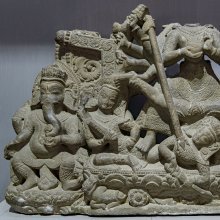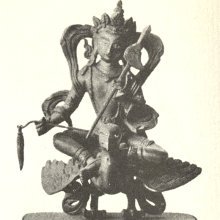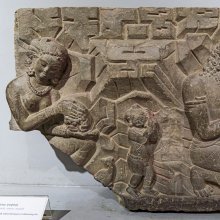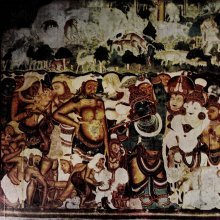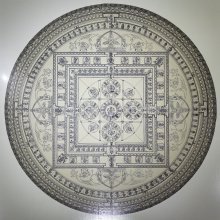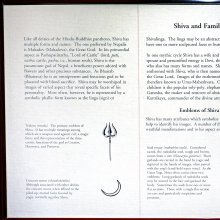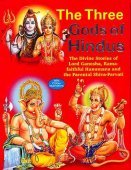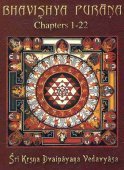Karttikeya, Kārtikeya, Kārttikeya, Kartikeya: 27 definitions
Introduction:
Karttikeya means something in Buddhism, Pali, Hinduism, Sanskrit, the history of ancient India. If you want to know the exact meaning, history, etymology or English translation of this term then check out the descriptions on this page. Add your comment or reference to a book if you want to contribute to this summary article.
Images (photo gallery)
(+13 more images available)
In Hinduism
Shilpashastra (iconography)
Source: Wisdom Library: Elements of Hindu IconograpyKārttikeya (one of the aspects of Subrahmaṇya, according to the Kumāra-tantra). He should have six faces and six arms and be of the colour of the rising sun. Two of his front hands should be kept in the abhaya and the varada poses, while the rest should carry vajra, kheṭaka, śakti and khaḍga.
According to the Śrītatvanidhi, Kārttikēya should have one face with three eyes, ten arms and the complexion of the rising sun. There should be a fruit (or leaf) of the bilvā three on the head and in the right hands the śūla, the chakra, the aṅkuśa, and abhaya; in the left hands the tomara, the pāśa, the śaṅkha, and the vajra and varada. He should have his peacock vehicle by his side. The complexion of this aspect of Subrahmaṇya should also be that of the rising sun.
Source: What is India: Inscriptions of the Śilāhāras (shilpashastra)Karttikeya (कर्त्तिकेय) as depicted according to images found found in the hills near Ciplun in the Ratnāgiri district.—Of the six faces of Kārttikeya, five are seen, two on each side of the central one. The god is standing in the samabhaṅga pose. The image is 71 cm. in height. All the heads have kirīṭa-mukuṭas studded with jewels. Two of his twelve hands are now broken, but those that are undamaged are shown holding the arrow, the mace, the bow, the lotus, etc. He wears the yajñopavīta and the champaka-mālā reaching below the knees. The tassels of his elaborately carved girdle are shown gracefully hanging on his legs. To his left is seen his vehicle, the peacock, and to his right a female chawri-bearer.
Source: Shodhganga: The significance of the mūla-beras (śilpa)Kārtikeya is the name of a deity depicted in the Adi Kumbeswarar Temple (Ādi Kumbheśvara) in Kumbakonam (Kumbhakonam), representing a sacred place for the worship of Śiva.—Kārtikeya is found seated on the peacock with his consorts standing on either side of him. He is found with four hands.

Shilpashastra (शिल्पशास्त्र, śilpaśāstra) represents the ancient Indian science (shastra) of creative arts (shilpa) such as sculpture, iconography and painting. Closely related to Vastushastra (architecture), they often share the same literature.
Vaishnavism (Vaishava dharma)
Source: ISKCON Press: GlossaryKārttikeya (कार्त्तिकेय).—The younger son of Lord Śiva and Pārvatī. He is the presiding deity of warfare. Also known as Subrahmanya or Skanda.

Vaishnava (वैष्णव, vaiṣṇava) or vaishnavism (vaiṣṇavism) represents a tradition of Hinduism worshipping Vishnu as the supreme Lord. Similar to the Shaktism and Shaivism traditions, Vaishnavism also developed as an individual movement, famous for its exposition of the dashavatara (‘ten avatars of Vishnu’).
Purana and Itihasa (epic history)
Source: archive.org: Puranic EncyclopediaKārttikeya (कार्त्तिकेय).—Skanda, the son of Śiva. For details see under Skanda.
Source: archive.org: Nilamata Purana: a cultural and literary studyKārttikeya (कार्त्तिकेय) is the name of a deity once worshipped in ancient Kashmir (Kaśmīra) according to the Nīlamatapurāṇa.—The term Kārttikeya is referred to once in the Nīlamata, his other names Skanda and Kumāra being more common. The mention of the worship of Kṛttikās along with Kārttikeya, anticipates the story of his being reared up by Kṛttikās.
Source: archive.org: Shiva Purana - English TranslationKārtikeya (कार्तिकेय) is the name of a deity corresponding to a “Rudraksha with six faces” (Ṣaḍvaktra), according to the Śivapurāṇa 1.25, while explaining the greatness of Rudrākṣa:—“[...] a Rudrākṣa with six faces (Ṣaḍvaktra) is Kārtikeya. A man who wears it on the right arm is certainly absolved of the sins of Brahmin-slaughter and the like”.
Source: Cologne Digital Sanskrit Dictionaries: The Purana Index1a) Kārttikeya (कार्त्तिकेय).—(Guha)—a god with his vāhana as peacock; conqueror of Krauñca of Asuras; also Kumāra;1 brought up by the Kṛttikas;2 delight to the mind of Umā;3 overheard the report given by his father to Pārvati on the subject of the colour of his throat, the Nīlakaṇṭha legend, when he was lying down on the lap of Umā on the top of the Kailāsa hills.4 Took part in Bāṇa's war with Kṛṣṇa and disabled by Garuḍa and Pradyumna.5
- 1) Brahmāṇḍa-purāṇa II. 25. 16; III. 10. 44; 32. 23; 41. 32; 42. 6; 43. 31.
- 2) Vāyu-purāṇa 41. 38; 72. 43; Viṣṇu-purāṇa I. 15. 116.
- 3) Vāyu-purāṇa 54. 19.
- 4) Vāyu-purāṇa 54. 28f.
- 5) Viṣṇu-purāṇa V. 33. 21 and 26.
1b) Kumāra, being the son of Kṛttikas; narrates the mahātmya of Nandi in nandīpurāṇa,1 born in the full moon day of the citra month and Indra made sin into one on the fifth day and on the sixth anointed devasenāpati. All important gods gave him some present or other and praised him.2 Promised to slay Tāraka and slew him.3 Image of; 12 hands in a city, four in a kharvaṭa and two in a village; one of the hands has a cock; others detailed.4
1c) (Pāvaki) a sage of the Rohita epoch.*
- * Brahmāṇḍa-purāṇa IV. 1. 62.
1d) A tīrtha sacred to Yāśaskari.*
- * Matsya-purāṇa 13. 45.
Kartikeya in the Mahabharata: In a complicated story, he is said to have been born from Agni and Svaha, after the latter impersonated the six of the seven wives of the Saptarishi (Seven Sages).
The Bhagavad-Gita (Ch.10, Verse 24), Krishna, while explaining his omnipresence, names the most perfect being, mortal or divine, in each of several categories. While doing so, he says: "Among generals, I am Skanda, the lord of war."
Source: WikiPedia: PuranasKartikeya in the Puranas: Though slightly varying versions occur in the Puranas, they broadly follow the same pattern. By this period, the identification of Shiva/Rudra with Agni, that can be traced back to the Vedas and Brahmanas, had clearly made Kartikeya the son of Shiva
Source: JatLand: List of Mahabharata people and placesKārtikeya (कार्तिकेय) is a name mentioned in the Mahābhārata (cf. I.60.23) and represents one of the many proper names used for people and places. Note: The Mahābhārata (mentioning Kārtikeya) is a Sanskrit epic poem consisting of 100,000 ślokas (metrical verses) and is over 2000 years old.

The Purana (पुराण, purāṇas) refers to Sanskrit literature preserving ancient India’s vast cultural history, including historical legends, religious ceremonies, various arts and sciences. The eighteen mahapuranas total over 400,000 shlokas (metrical couplets) and date to at least several centuries BCE.
Kavya (poetry)
Source: Wisdom Library: KathāsaritsāgaraKārttikeya (कार्त्तिकेय) is the name of Śiva’s son born for the purpose of slaying the asura Tāraka and to protect the realm of Indra, according to the Kathāsaritsāgara, chapter 20. Accordingly, “Long ago, when Indra, oppressed by Tāraka, was desirous of obtaining a son from Śiva to act as general of the gods... ”. Also, when Śiva addressed Kārttikeya, “Thou wast born in order that thou mightest slay Tāraka and protect the realm of Indra, therefore do thy own duty”.
Kārttikeya was born out of the fire having six faces. Accordingly, “When thus addressed by Śiva, the goddess (Umā) worshipped Gaṇeśa, and the fire became pregnant with that germ of Śiva. Then, bearing that embryo of Śiva, the fire shone even in the day as if the sun had entered into it. And then it discharged into the Ganges the germ difficult to bear, and the Gaṇas, by the order of Śiva, placed it in a sacrificial cavity on Mount Meru. There that germ was watched by the Gaṇas, Śiva’s attendants, and after a thousand years had developed it, it became a boy with six faces.”
The name Kārttikeya is derived from the fact he was nursed by the breasts of the six Kṛttikās. Accodingly, “Then, drinking milk with his six mouths from the breasts of the six Kṛttikās appointed by Gaurī to nurse him, the boy grew big in a few days.”
The Kathāsaritsāgara (‘ocean of streams of story’), mentioning Kārttikeya, is a famous Sanskrit epic story revolving around prince Naravāhanadatta and his quest to become the emperor of the vidyādharas (celestial beings). The work is said to have been an adaptation of Guṇāḍhya’s Bṛhatkathā consisting of 100,000 verses, which in turn is part of a larger work containing 700,000 verses.

Kavya (काव्य, kavya) refers to Sanskrit poetry, a popular ancient Indian tradition of literature. There have been many Sanskrit poets over the ages, hailing from ancient India and beyond. This topic includes mahakavya, or ‘epic poetry’ and natya, or ‘dramatic poetry’.
Vyakarana (Sanskrit grammar)
Source: Wikisource: A dictionary of Sanskrit grammarKārtikeya (कार्तिकेय).—The original instructor of the Kātantra or Kālāpa Grammar, to Śarvavarman who composed the Sūtras according to inspiration received by him. The Kātantra, hence, has also got the name Kaumara Vyākaraṇa.

Vyakarana (व्याकरण, vyākaraṇa) refers to Sanskrit grammar and represents one of the six additional sciences (vedanga) to be studied along with the Vedas. Vyakarana concerns itself with the rules of Sanskrit grammar and linguistic analysis in order to establish the correct context of words and sentences.
Shaivism (Shaiva philosophy)
Source: Shodhganga: The saurapurana - a critical study (shaivism)Kārttikeya (कार्त्तिकेय) or Kumāra is a deity of high rank and the son of Śiva, according to the 10th century Saurapurāṇa: one of the various Upapurāṇas depicting Śaivism.—Kārttikeya is also called Skanda, Mahāsena etc.—The birth of Skanda-Kārttikeya is related in chapter sixty two of the Saurapurāṇa. He is frequently mentioned and indeed is more and more brought into the likeness of his father, Śiva. His position as compared with the other gods is significant; Indra foolishy seeks to war with him, but is defeated with humilation. He accepts the Generalship of the divine army and kills Tāraka. Worship of Skanda in Śaiva temples is enjoined in the Saurapurāṇa.

Shaiva (शैव, śaiva) or Shaivism (śaivism) represents a tradition of Hinduism worshiping Shiva as the supreme being. Closely related to Shaktism, Shaiva literature includes a range of scriptures, including Tantras, while the root of this tradition may be traced back to the ancient Vedas.
General definition (in Hinduism)
Source: WikiPedia: HinduismKartikeya is the Hindu god of war. He is the commander-in-chief of the army of the devas (gods) and the son of Shiva and Parvati. Kartikeya symbols are based on the weapons – Vel, the Divine Spear or Lance that he carries and his mount the peacock. He is sometimes depicted with many weapons including: a sword, a javelin, a mace, a discus and a bow although more usually he is depicted wielding a sakti or spear. This symbolizes his purification of human ills. His javelin is used to symbolize his far reaching protection, his discus symbolizes his knowledge of the truth, his mace represents his strength and his bow shows his ability to defeat all ills. His peacock mount symbolizes his destruction of the ego.
The Atharva Veda describes Kumaran as 'Agnibhuh' because he is form of 'Agni' (Fire God) & Agni held him in his hands when Kumaran was born. The Satapatha Brahmana refers to him as the son of Rudra and the six faces of Rudra.
In Buddhism
Tibetan Buddhism (Vajrayana or tantric Buddhism)
Source: archive.org: The Indian Buddhist IconographyMaheśvara (महेश्वर) is the name of a deity commonly depicted in Buddhist Iconography, and mentioned in the 11th-century Niṣpannayogāvalī of Mahāpaṇḍita Abhayākara.—His Colour is red; his Symbol is a hen; his Vehicle is the peacock; he has six arms.
Kārttikeya is described in the Niṣpannayogāvalī (dharmadhātuvāgīśvara-maṇḍala) as follows:—
“Kārttikeya rides a Peacock, is red in colour, and has six faces. With the two right hands he holds the śakti (javelin) and the vajra and with the two left the hen. With two others he shows the añjali”.

Tibetan Buddhism includes schools such as Nyingma, Kadampa, Kagyu and Gelug. Their primary canon of literature is divided in two broad categories: The Kangyur, which consists of Buddha’s words, and the Tengyur, which includes commentaries from various sources. Esotericism and tantra techniques (vajrayāna) are collected indepently.
India history and geography
Source: Singhi Jain Series: Ratnaprabha-suri’s Kuvalayamala-katha (history)Kārttikeya (कार्त्तिकेय) is the name of a Six-headed God who was worshiped in ancient India, as depicted in the Kathās (narrative poems) such as Uddyotanasūri in his 8th-century Kuvalayamālā (a Prakrit Campū, similar to Kāvya poetry).—Page 82.30: Here is a list of religious establishments of different denominations as mantra-jāpa-maṇḍapa, brāhmaṇa-śālā, rudra-bhavana, dhārmika-maṭha, Home of Kāpālikas, Holy platforms of Yakṣas, Nāgas etc., Brahmanical songs were sung in āvasati, Jinagṛha, Buddhavihāra or Buddhist monasteries, Shrine of goddess Kottavī, Temple of six-headed god Kārttikeya and temple of other deities.

The history of India traces the identification of countries, villages, towns and other regions of India, as well as mythology, zoology, royal dynasties, rulers, tribes, local festivities and traditions and regional languages. Ancient India enjoyed religious freedom and encourages the path of Dharma, a concept common to Buddhism, Hinduism, and Jainism.
Languages of India and abroad
Sanskrit dictionary
Source: DDSA: The practical Sanskrit-English dictionaryKārtikeya (कार्तिकेय).—[kṛttikānāmapatyaṃ ḍhak] Name of Skanda (so called because he was reared by the six Kṛttikās). [Kārtikeya is the Mars or the god of war of the Indian mythology. He is the son of Śiva (but born without the direct intervention of a woman). Most of his epithets have reference to the circumstances of his birth. Śiva cast his seed into Agni (who had gone to the god in the form of a dove, while he was enjoying Pārvatī's company), who being unable to bear it cast it into the Ganges; (hence Skanda is called Agnibhū, Gaṅgāputra). It was then transferred to the six Kṛttikās (when they went to bathe in the Ganges), each of whom therefore conceived and brought forth a son. But these six sons were afterwards mysteriously combined into one of extraordinary form with six heads and twelve hands and eyes, (hence he is called Kārtikeya, Ṣadānana, Ṣaṇmukha &c.). According to another account the seed of Śiva was cast by the Ganges into a thickest of reeds (Śara); whence the boy was called Śaravaṇabhava, or Śarajanman. He is said to have pierced the mountain Krauñcha, whence his name Krauñchadāraṇa. He was the commander of the army of the gods in their war with Tāraka, a powerful demon (q. v.) whom he vanquished and slew; and hence his names Senānī and Tārakajit. He is represented as riding a peacock.]
Derivable forms: kārtikeyaḥ (कार्तिकेयः).
Source: Cologne Digital Sanskrit Dictionaries: Shabda-Sagara Sanskrit-English DictionaryKārttikeya (कार्त्तिकेय).—m.
(-yaḥ) Kartikeya, the deity of war and son of Siva. E. kṛttikā the personified Pleiades, and ḍhak affix: according to the legend, having been fostered and brought up by the nymphs so called.
Source: Cologne Digital Sanskrit Dictionaries: Benfey Sanskrit-English DictionaryKārttikeya (कार्त्तिकेय).—i. e. kṛttikā + eya, m. The god of war, [Rāmāyaṇa] 1, 37, 20.
Source: Cologne Digital Sanskrit Dictionaries: Cappeller Sanskrit-English DictionaryKārttikeya (कार्त्तिकेय).—[masculine] metron. of Skanda.
Source: Cologne Digital Sanskrit Dictionaries: Monier-Williams Sanskrit-English DictionaryKārttikeya (कार्त्तिकेय):—[from kārttika] m. Name of a son of Śiva and Pārvatī (popularly regarded as god of war, because he leads the Gaṇas or hosts of Śiva against the demon hosts See, [Religious Thought and Life in India] p.213; [according to] to one legend he was son of Śiva without the intervention of Pārvatī, the generative energy of Śiva being cast into the fire and then received by the Ganges, whence he is sometimes described as son of Agni and Gaṅgā; when born he was fostered by the six Kṛttikās q.v., and these offering their six breasts to the child he became six-headed; he is also called Kumāra, Skanda, and Subrahmaṇya; his Name Kārttikeya may be derived from his foster mothers or from the month Kārttika as the best for warfare: in the [Mṛcchakaṭikā] and elsewhere he is regarded as presiding over thieves), [Mahābhārata etc.]
Source: Cologne Digital Sanskrit Dictionaries: Yates Sanskrit-English DictionaryKārttikeya (कार्त्तिकेय):—(yaḥ) 1. m. Kārtikeya the deity of war, and son of Shiva.
Source: DDSA: Paia-sadda-mahannavo; a comprehensive Prakrit Hindi dictionary (S)Kārttikeya (कार्त्तिकेय) in the Sanskrit language is related to the Prakrit word: Kattikea.
[Sanskrit to German]
Sanskrit, also spelled संस्कृतम् (saṃskṛtam), is an ancient language of India commonly seen as the grandmother of the Indo-European language family (even English!). Closely allied with Prakrit and Pali, Sanskrit is more exhaustive in both grammar and terms and has the most extensive collection of literature in the world, greatly surpassing its sister-languages Greek and Latin.
Kannada-English dictionary
Source: Alar: Kannada-English corpusKārtikēya (ಕಾರ್ತಿಕೇಯ):—[noun] Skanda, the god of war and son of Siva, fostered by six stars of the Pleiades.
Kannada is a Dravidian language (as opposed to the Indo-European language family) mainly spoken in the southwestern region of India.
See also (Relevant definitions)
Starts with: Karttikeya-mukha, Karttikeyanagara, Karttikeyani, Karttikeyapada, Karttikeyapasu, Karttikeyaprasu, Karttikeyapura, Karttikeyashashthi, Karttikeyasiddhanta, Karttikeyavrata, Karttikeyeshvara.
Ends with: Svamikarttikeya.
Full-text (+723): Gaurija, Shikhivahana, Yuddharanga, Parvatinandana, Paravani, Ambikeya, Shambhutanaya, Krauncadarana, Bahuleya, Gangasuta, Siddhasena, Mahasena, Krauncarati, Mahashakti, Senani, Skanda, Sharajanman, Shanmukha, Dvadashalocana, Umasuta.
Relevant text
Search found 81 books and stories containing Karttikeya, Kārtikēya, Kārtikeya, Kartikēya, Kartikeya, Kārttikeya; (plurals include: Karttikeyas, Kārtikēyas, Kārtikeyas, Kartikēyas, Kartikeyas, Kārttikeyas). You can also click to the full overview containing English textual excerpts. Below are direct links for the most relevant articles:
Garga Samhita (English) (by Danavir Goswami)
Verse 1.12.44 < [Chapter 12 - Description of Śrī Nanda’s Festival]
Verse 2.5.18 < [Chapter 5 - The Liberation of Bakāsura]
Verses 6.10.22-23 < [Chapter 10 - In the Description of the Gomatī River, the Glories of Cakra-tīrtha]
The Shiva Purana (by J. L. Shastri)
Chapter 5 - Kārttikeya is crowned < [Section 2.4 - Rudra-saṃhitā (4): Kumāra-khaṇḍa]
Chapter 37 - Śaṅkhacūḍa fights with the full contingent of his army < [Section 2.5 - Rudra-saṃhitā (5): Yuddha-khaṇḍa]
Chapter 21 - Description of the Special War < [Section 2.5 - Rudra-saṃhitā (5): Yuddha-khaṇḍa]
The Padma Purana (by N.A. Deshpande)
Chapter 69 - The Slaying of Tāreya < [Section 1 - Sṛṣṭi-khaṇḍa (section on creation)]
Chapter 121 - The Importance of Offering Lights etc. < [Section 6 - Uttara-Khaṇḍa (Concluding Section)]
Chapter 122 - The Celebration of Dīpāvalī < [Section 6 - Uttara-Khaṇḍa (Concluding Section)]
Middle Chola Temples (by S. R. Balasubrahmanyam)
Temples in Pasuvandanai < [Chapter II - Temples of Rajaraja I’s Time]
Temples in Tiruvalisvaram < [Chapter II - Temples of Rajaraja I’s Time]
Temples in Seramadevi < [Chapter II - Temples of Rajaraja I’s Time]
Mahabharata (English) (by Kisari Mohan Ganguli)
The Devi Bhagavata Purana (by Swami Vijñanananda)
Related products
